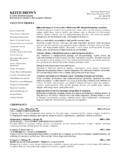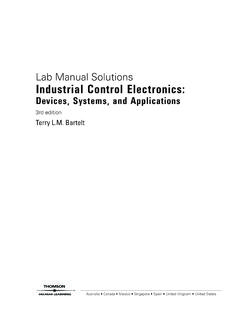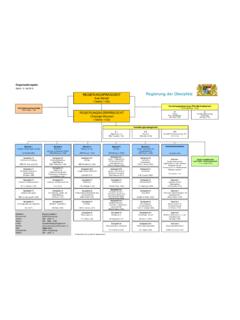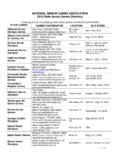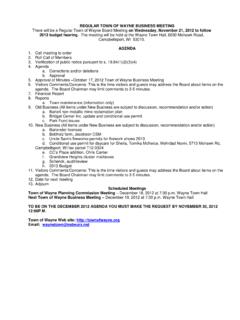Transcription of 111SUSTAINED RECOVERY MANAGEMENT
1 2 Treatnet: International Network of Drug Dependence Treatment and Rehabilitation Resource Centres. Good practice document Sustained RECOVERY MANAGEMENT Good Practice Vienna, September 2008 3 Disclaimer The views expressed in this good practice document are those of the authors and do not necessarily reflect the policies or views of UNODC. A reference to a document or a website does not imply endorsement by UNODC of the accuracy of the information contained therein. This document has not been formally edited yet. This good practice document has been prepared by a professionally and geographically diverse working group with participants from five drug dependence treatment centres as part of UNODC project GLO/H43 Treatnet International Network of Drug Dependence Treatment and Rehabilitation Resource Centres.
2 It was peer reviewed to assure comprehensiveness and its relevance to different sociocultural environments as well as a balanced representation of different perspectives on the issue. 4 Acknowledgements The present publication is one of a series of four documents developed under UNODC project GLOH43: Treatnet-International network of drug dependence treatment and rehabilitation resource centres. It responds to UNODC s mandate, to develop and disseminate good practice in the field of drug dependence treatment.
3 During Phase I an international network of drug dependence treatment and rehabilitation resource centres in all regions was initiated, with a view to facilitating dissemination of knowledge and good practices. This document has been produced by members of one of four working group consisting of representatives from Treatnet members and the topics of the documents include: Community Based Treatment Interventions for Drug Users in Prisons The Role of Drug Dependence Treatment on the Prevention and Care of HIV and AIDS Sustained RECOVERY MANAGEMENT .
4 The United Nations Office on Drugs and Crime expresses its gratitude to the following: The donors of project GLO/H43: The Governments of Canada, Germany, The Netherlands, Spain, Sweden, The United States of America and the Robert Wood Johnson Foundation for their generous contribution. All Treatnet Resource Centres (in alphabetical order by country) participating in the working group on Sustained RECOVERY MANAGEMENT and the respective Treatnet Focal Points for their professionalism, commitment, enthusiasm and the mutual support given to each other as well as the financial and time resources dedicated to the network.
5 Mario Alberto Zapata on behalf of CARISMA- Centre for Attention and Integral Rehabilitation of Mental Health, Medellin (Colombia) Max Hopperdietzel on behalf of Mudra, N rnberg (Germany) Shanti Ranganathan on behalf of TT Ranganathan Clinical Research Foundation, Chennai (India) Akinwande Akinhanmi on behalf of Neuropsychiatric Hospital Aro, Abeokuta (Nigeria) Mike Boyle on behalf of Fayette Companies, Peoria, Illinois (USA) 5 UNODC and the working group on Sustained RECOVERY MANAGEMENT would like to express their special thanks to the international experts, who have commented on an earlier draft of this document, for their generous support, insights constructive feedback and contributions to improve and finalize the Treatnet publications (in alphabetical order).
6 Natalie Bartelt, Gesellschaft f r Technische Zusammenarbeit (GTZ) Anna de Boer, Independent Consultant, Capacity Development and Coaching Nicholas Clark, World Health Organization James Egan, Scottish Drugs Forum David MacDonald, International drugs and development advisor Patricia Kramerz, Gesellschaft f r Technische Zusammenarbeit (GTZ) Ingo Ilja Michels, Office of the Federal Drug Commissioner, Federal Ministry of Health, Germany Jacek Moskalewicz, Department of Studies on Alcoholism and Drug Dependence, Institute of Psychiatry and Neurology Warsaw, Poland Vladimir Poznyak, World Health Organization Nicola Singleton, UK Drug Policy Commission, RECOVERY Consensus Group Robert van Lavieren, United Nations Industrial Development Organization Inez Wijngaarde, United Nations Industrial Development Organization UNODC colleagues.
7 Cristina Albertin (UNODC Bolivia), Kham Noan Hsam (UNODC Laos), Estella Maris-Deon (UNODC Vienna), Anja Korenblik (UNODC Viena), Isabel Palacios (UNODC Peru), Jorge Rios (UNODC Viena) Furthermore UNODC and the Treatnet working group on Sustained RECOVERY Managament would like to thank the following persons for their substantive contributions to this document: Consuelo Cassarotto, alternative development and livelihoods expert Marguerite Sheila Martindale, WildMind Communications David Moore, Fayette Companies Arun Pinto, MD, Vice President of Medical Services, Fayette Companies William White, Chestnut Health Systems/Lighthouse Institute Maria J.
8 Zarza, University of California Los Angeles Integrated Substance Abuse Program (UCLA/ISAP) and all those who have provided the information for the case studies (Chapter IV) 6 Table of contents Page Introduction and Overview A Brief Background Definitions of Good, Evidence-based, and Promising Practice Who Can Use This Manual Overview of Chapters Chapter I: A Sustained RECOVERY MANAGEMENT Approach Sustainable Livelihoods A RECOVERY Framework RECOVERY Capital A Sustained RECOVERY MANAGEMENT Approach Benefits of a Sustained RECOVERY MANAGEMENT Approach Chapter II: Components of Sustained RECOVERY MANAGEMENT The Components of Sustained RECOVERY MANAGEMENT Domain 1: Physical and mental health Domain 2: Family, Social Supports, and Leisure Activities Domain 3: Safe Housing and Environments Conducive to Health and RECOVERY Domain 4: Peer-based Support Domain 5.
9 Employment and Resolution of Legal Issues Domain 6: Vocational Skills and Educational Development Domain 7: Community Integration and Cultural Renewal Domain 8: Pathways to (Re)discovering Meaning and Purpose in Life Chapter III: Laying the Groundwork for Building RECOVERY Capital Laying the Groundwork for Building RECOVERY Capital Steps towards Building RECOVERY Capital Domain 1: Physical and Mental Health Supports Domain 2: Family, Social supports, and Leisure Activities Domain 3: Safe Housing and Environments Conducive to Health and RECOVERY Domain 4: Peer-based Support Domain 5: Employment and Resolution of Legal Issues Domain 6: Vocational Skills and educational development Domain 7: Community integration and cultural renewal Domain 8: Meaning and Purpose in Life 7 Chapter IV: Case Studies Promising Practices in Action Promoting Micro Enterprises and Vocational Training in the Cochabamba Tropics: Bolivia Education: Cambodia Cultural Support: Canada Vocational Skills Training and Employment: Germany Special Employment Programme for At-Risk Youth: Honduras Family Support.
10 India Vocational Skills Training and Employment: Nigeria Legal Support: Spain Peer Support: United States of America Chapter V: Advocacy Target Groups at the Personal and Community Levels Target Groups at the Institutional and National Levels Advocacy Methods Information Sources Chapter VI: Sustained RECOVERY MANAGEMENT : Documentation and Evaluation A Step-by-Step Approach to Documentation and Evaluation Step 1: Set up an evaluation group Step 2: Describe the programme in detail Step 3: Assess the resources available for conducting an evaluation Step 4: Identify and prioritize areas of evaluation Step 5: Generate evaluation questions Step 6: Programme design Step 7: Selecting measures or instruments Step 8: Managing data Step 9: Analysing and interpreting data Step 10: Using the results and lessons learned Appendix I: Figures for Chapters I and III Appendix II: Screening and Assessment Instruments Appendix III.










